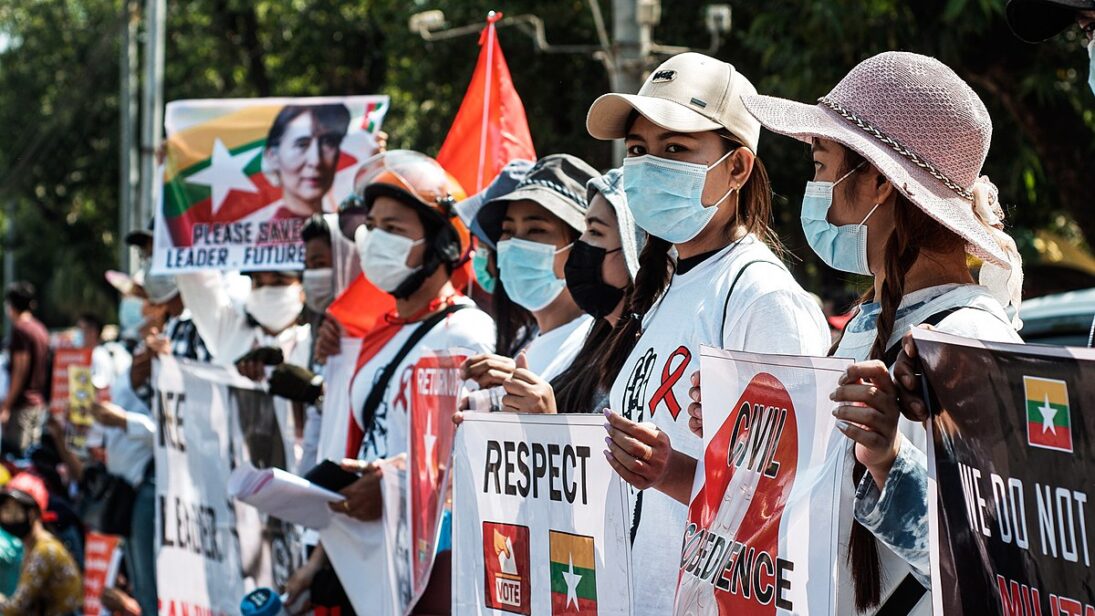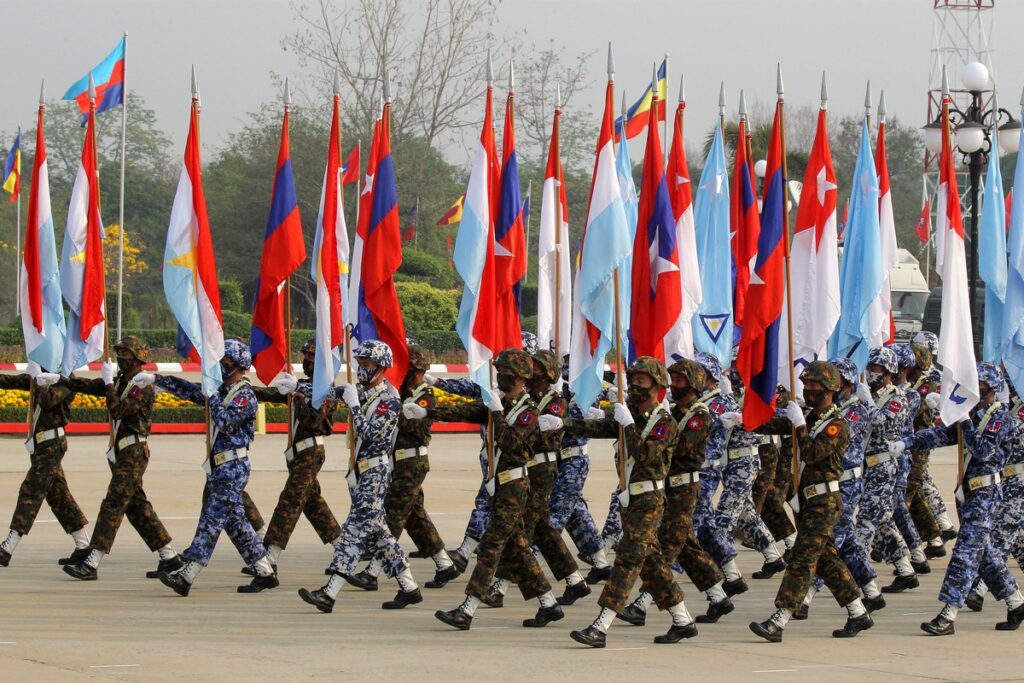
By Cchavi Vasisht
Myanmar, a nation once on the path to democracy, is now engulfed in a devastating crisis. Especially since October 2023, when the Three Brotherhood Alliance (3BTA) launched a coordinated attack called Operation 1027 against the junta in the Shan State followed by subsequent attacks by the ethnic armies, the military has been facing significant battlefield setbacks. As a result, the country is under twin threats of intensified armed conflict and a failing economy. Myanmar’s GDP remains 12 percent below pre-coup levels and inflation has skyrocketed along with a weakening currency. Furthermore, the escalating conflict in Myanmar is impacting the South and Southeast Asian region’s security and economic growth accompanied by a cross-border humanitarian crisis. Therefore, the military coup in 2021 set in motion a devastating chain reaction, leading to civil war, economic collapse, a humanitarian crisis, and regional instability. Addressing this crisis requires a multi-pronged approach focused on humanitarian aid, inclusive dialogue, and regional cooperation. India, through expanded diplomacy, collaboration with its Northeastern states, and a balanced approach to border security, can promote stability in Myanmar and counter China’s growing influence in the region.
Civil War Escalates: Humanitarian and Economic Crises Deepen
Since the military ousted the civilian government in February 2021, conflict emerged throughout many parts of Myanmar between the military, the National Unity Government (NUG) and its People Defence Forces (PDFs) and many Ethnic Armed Organizations (EAOs). Since October 2023, Myanmar’s civil war has sharpened, especially with the latest drone attacks on the capital Naypyidaw by opposition groups. Ethnic armed groups like the Kachin Independence Army (KIA) and Arakan Army (AA) have made significant gains and the military struggles to retake lost territories. However it is also crucial to note that there are differences within ethnic armies as well, such as increased tensions between the Myanmar National Democratic Alliance Army (MNDAA) and Ta’ang National Liberation Army (TNLA) in April. The military junta’s actions, including alleged air attacks on civilians, the burning of villages, mandating conscription (including from the Rohingya minority) have further exacerbated the crisis.
The United Nations noted that more than 3 million people in Myanmar have been displaced since the military coup. Displacement has increased by 50 percent in the past six months, primarily concentrated in northwestern regions such as Chin, Magway, and Sagaing, as well as in southeastern areas. Approximately 18.6 million people are now in need of humanitarian assistance, marking an increase of a million from the previous year. However, efforts to reach those in need are hampered by underfunding as well as restrictions imposed by the military.
Following the coup, Myanmar’s economy has also experienced a significant downturn, with the GDP dropping to 12% below its pre-coup levels. Inflation has skyrocketed to over 20%, with food prices tripling and the currency, Kyat, has depreciated. Further, these armed conflicts have been the primary cause of food insecurity, with Myanmar ranked as the tenth worst affected country. Household incomes, which were on track to either remain stagnant or decrease with reduction in poverty rates, rose to 49.7 percent in 2023. Furthermore, Myanmar’s revenue streams have shrunk due to a widening trade deficit, declining foreign investment, and reduced tax revenues. The country experienced a trade deficit exceeding one billion USD in January, along with a loss of border trade. To tackle economic challenges, the military regime has engaged with various partners such as Russia and China but the effectiveness of these initiatives remains uncertain, particularly given the ongoing conflict and international sanctions.
Implications for South Asia and Southeast Asia
Myanmar’s ruling military junta is facing significant battlefield defeats and economic turmoil, challenging its capacity to maintain control and stability in the country. However, it continues to retain firepower and control over certain regions, suggesting that the conflict could persist, albeit with a weakened military in the long run. Neighboring states, especially India, are already seeing negative ramifications from this ongoing crisis.
Internal displacement in Myanmar is leading to a surge in refugees fleeing to neighboring countries, especially India, Bangladesh, and Thailand, creating humanitarian crises. The conflict is also leading to an increase in drug trafficking and the illegal arms trade in the region, potentially empowering insurgent groups in countries bordering Myanmar. A classic case here is that of India, which has witnessed a rise of insurgent activities in its Northeast region, especially Manipur. The conflict and economic downturn in Myanmar have also disrupted trade flows and investments. Major regional connectivity projects are stalled–for instance, India’s Kaladan Multi Modal Project is in limbo given the escalated conflict in the Rakhine state.

Finally, the geopolitics of the region is shifting. With increased sanctions from Western nations, Myanmar is edging closer to China. For instance, China is pushing the military junta to implement and protect its projects and investments in the country. Simultaneously, China has also reached out to the NUG to safeguard its interests, which resulted in the NUG releasing its 10-point China policy in January this year. China’s growing economic and political influence in Myanmar is seen as a threat by other regional powers like India, leading to increased competition and potential proxy conflicts.
Way Forward to Restore Normalcy
While no external power can make a direct intervention in Myanmar, the regional actors, especially India, have a significant role to play in encouraging normalcy to return in the country. First, the Indian government would do well to broaden its engagement with multiple stakeholders in Myanmar, expanding its diplomatic reach beyond the ruling military. This includes the NUG and other EAOs. It is essential to establish communication with ethnic groups controlling border areas, particularly the Kachin, Nagas, Chin, and Rakhine, which are crucial for India’s border security and regional stability. To ensure an inclusive dialogue, India could appoint a dedicated interlocutor or special envoy to Myanmar to coordinate talks between different stakeholders, such as the military, NUG, and other EAOs. India could also propose utilizing existing regional frameworks like ASEAN Plus and the Quad to push for peacebuilding initiatives in Myanmar.
Second, India’s Northeastern states share cultural and ethnic ties with Myanmar’s border regions. India could leverage these existing connections to address the crisis by utilizing shared languages, traditions, and family ties for gathering ground information and understanding local needs. These connections can further facilitate trust-building and effective communication for humanitarian aid distribution and peacebuilding initiatives. Cross-border cooperation can also address issues like drug trafficking and human smuggling through sharing of best practices and conducting joint border patrols. Third, India needs to balance its security interests with the need for openness of borders to ensure movement of people. While India should reconsider its decision to completely fence the borders by removing the Free Movement Regime, it can implement temporary fencing in areas facing instability to control movement and prevent spillover of violence. Additionally, India can utilize drones and other modern surveillance technology for better border monitoring.
Finally, it may be worthwhile for India to recalibrate its development assistance programs in Myanmar, with an eye on the growing Chinese influence in the country. The focus can be on capacity building initiatives that empower local communities. India’s policy should emphasize building long-term relationships with various stakeholders in Myanmar, which would not only benefit Myanmar but also safeguard India’s own strategic interests. Such proactive engagement from New Delhi can prevent China from dominating the situation.
In the end, it is pertinent to remember that the current challenges in Myanmar stem out of certain inherent problems in the country itself. Therefore, there is an urgent need for an inclusive dialogue involving all stakeholders in Myanmar, which should address the root causes of the conflict such as ethnic tensions, excessive military involvement in civilian government, and reworking provisions of the 2008 Constitution. This dialogue should be Myanmar owned and Myanmar led, though regional actors like India can help in facilitating it. The situation in Myanmar remains complex, and the path forward will be challenging. However, a multi-pronged approach that prioritizes humanitarian assistance, inclusive dialogue, and regional cooperation with immediate neighbors offers a glimmer of hope for a peaceful and democratic future.
source : southasianvoices
